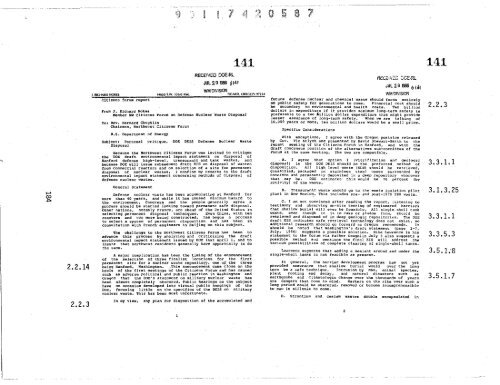EIS-0113_Section_9 - Hanford Site
EIS-0113_Section_9 - Hanford Site
EIS-0113_Section_9 - Hanford Site
Create successful ePaper yourself
Turn your PDF publications into a flip-book with our unique Google optimized e-Paper software.
111<br />
W"<br />
N<br />
2.2.14<br />
2.2,3<br />
RECEIVED DOE-RL<br />
JUL 291986 6141<br />
@IM DIVISION<br />
1. RKHARD NOSES 14650 S.W. 103M AW. TIGARD, OREGON 97224<br />
citizens forum report<br />
From S. Richard Makes<br />
Member NN Citizens Forum on Defense Nuclear Haste DrsPOSAI<br />
To! Rev. Bernard Coughlin<br />
Chairman, Northwest Citizens Forum<br />
O.S. Department of Energy<br />
Subject: Personal critique, DOE D<strong>EIS</strong> Defense Nuclear Waste<br />
Disposal<br />
Because the Northwest Citizens Forum was invited to critique<br />
the DOE draft environmental impact statement on disposal of<br />
<strong>Hanford</strong> defense high- level, transuranic and tank wastes, and<br />
because DOE will issue ..bsaquent draft <strong>EIS</strong> on disposal of wastes<br />
from commercial reactors and on selection of a. site for permanent<br />
disposal of nuclear wastes, I confine my remarks to the draft<br />
environmental impact statement concerning methods of disposal of<br />
defense nuclear wastes.<br />
General Statement<br />
Defense nuclear waste has been ac cumulating at <strong>Hanford</strong> for<br />
more than 40 years, and while it has caused minimum hazard to<br />
the environment. Congress and the people generally agree a<br />
process should be started looking toward permanent safedisposal.<br />
Other nations, notably France, are ahead of the United States in<br />
selecting permanent disposal techniques. Even China, with ten<br />
reactors and two more being constructed, has begun• process<br />
to select a system of permanent disposition and has been in<br />
consultation with French engineers in Beijing on this subject.<br />
The challenge to the Northwest Citizens Forum has been to<br />
advance this process by analyzing and criticizing the draft<br />
environmental impact statement issued by DOE last April 1, and to<br />
insure that northwest residents generally have Dpportunt ty to do<br />
the Same.<br />
A major complication has been the timing of the announcement<br />
of the selection of three finalist locations for the first<br />
permanent site for a nuclear waste repository, one of the three<br />
being <strong>Hanford</strong>, Washington. This announcement came close on the<br />
heels of the first meetings of the Citizens Forum and has caused<br />
such an adverse Political and public reaction in Washington and<br />
Oregon that the DOE's statement an military nuclear waste has<br />
been almost completely obscured. Public hearings on the subject<br />
have on occasion developed into virtual public hangings of the<br />
DoE, focusing little on the specifics of the D<strong>EIS</strong> on military<br />
nuclear waste. This has been most unfortunate.<br />
In my view, any plan for disposition of the accumulated and<br />
I<br />
RCCC11fEL :f,-9L<br />
14<br />
JUL 2919860<br />
WM DIVISION<br />
future defense nuclear and chemical waste should focus entirely<br />
on public safety for generations to come. Financial cost should<br />
be secondary to environmental and health costs. Ten billion<br />
dollars in expenditure if it provides maximum long-term safety is<br />
preferable to a two billion dollar expenditure that might provide<br />
lesser assurance of long-term safety. When we are talking of<br />
10,000 years or more, ten billion dollars would be a small price.<br />
Specific Considerations<br />
Withxceptions, I agree with the Oregon position released<br />
by Gov. Vic Atiyeh and presented by David Stewart-Smith to the<br />
recent meeting of the Citizens Forum in <strong>Hanford</strong>, and with the<br />
draft consensus position of the alternatives sub-committee of the<br />
Forum at the same meeting. The two are compatible..<br />
A. I agree that option 1 (vitrification and geologic<br />
dial, ... 1) in the DOE D<strong>EIS</strong> should be the preferred method of<br />
disposition. All high level waste(HLW) should be retrieved,<br />
glassified, packaged in stainless steel cases surrounded by<br />
concrete and permanently deposited in a deep repository wherever<br />
that may be. DOE estimates this would be 98 percent (by<br />
activity( of the waste.<br />
B. Transuranic waste should go to the waste isolation pilot<br />
plant in New Mexico. This includes pre- and post -1990 THU waste..<br />
C. I am not convinced after reading the report, listening to<br />
testimony and observing on-site testing of engineered barriers<br />
that shallow burial will ever be feasible. All single shell tank<br />
waste, even though it is in cake or sludge form, should be<br />
retrieved and disposed of in deep geologic repositories. The DOB<br />
draft <strong>EIS</strong> indicate. is retrieval technology does ..t exist, so<br />
additional research should go forward as Oregon recommends. It<br />
Should be noted that Washington's draft statement (page 2-7,<br />
July, 1986( suggests a passible solution. Mike Lawrence in his<br />
statement to the forum via Father Coughlin duly 3 also suggests a<br />
possible method and mentions the final SIB will address the<br />
various possibilities of complete clearing of single-shell tanks.<br />
Lawrence. suggests that adding a sealant around and under the<br />
single-shell. .tanks is not feasible at present.<br />
In general, the barrier development program has not yet<br />
providedsurance that shallow burial would over the long<br />
term be a safe technique. Intrusion byma animal species,.<br />
plant noting and decay, and natural disasters such as<br />
earthquake and climatologic change over the thousands of years<br />
are dangers that come to mind. Markers on the site over such a<br />
long period could be obscured, removed or become incomprehensible<br />
to man in millenia to come.<br />
D. Strontium and cesium wastes double encapsulated in<br />
2<br />
2.2.3<br />
3.3.1.1<br />
3.1.3.25<br />
3.3.1.1<br />
3.3.5.3<br />
3.5.1:8<br />
3.5.1.7

















